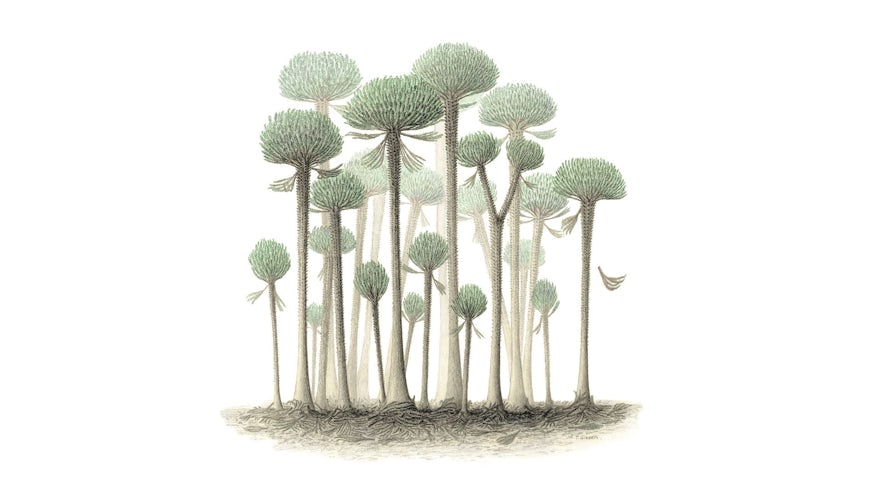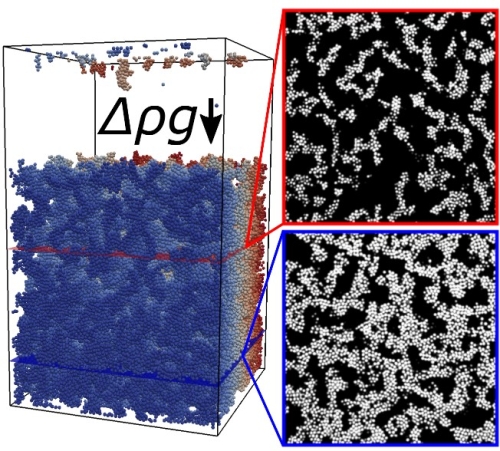2024-03-07 カーディフ大学
 A reconstruction of a Calamophyton forest, where trees drawn measure 2-3 meters high. Credit Peter Giesen/Chris Berry
A reconstruction of a Calamophyton forest, where trees drawn measure 2-3 meters high. Credit Peter Giesen/Chris Berry
<関連情報>
- https://www.cardiff.ac.uk/news/view/2800919-earths-earliest-forest-revealed-in-somerset-fossils
- https://www.lyellcollection.org/doi/abs/10.1144/jgs2023-204
地球最古の森林:イングランド南西部、サマセットとデヴォンにあるデボン紀中期(アイフェル紀)ハングマン砂岩層の樹木化石と植生による堆積構造 Earth’s earliest forest: fossilized trees and vegetation-induced sedimentary structures from the Middle Devonian (Eifelian) Hangman Sandstone Formation, Somerset and Devon, SW England
Neil S. Davies, William J. McMahon, and Christopher M. Berry
Journal of the Geological Society Published:23 February 2024
DOI:https://doi.org/10.1144/jgs2023-204
Abstract
The evolution of trees and forests through the Devonian Period fundamentally changed Earth’s land biosphere, as well as impacting physical environments and geomorphology by stabilizing sediment and interacting with flowing air and water. From the mid Givetian Age onwards, lignophyte flora are known to have been key parts of the machinery in the ‘Devonian Landscape Factory’, but the impact of earlier forests, dominated by less woody cladoxylopsids, are not as well understood. In this paper we report evidence for a previously unrecognized cladoxylopsid forest landscape, archived within the Eifelian Hangman Sandstone Formation of Somerset and Devon, SW England. This unit has previously been considered palaeobotanically depauperate but is here shown to contain the earliest fossil evidence for such trees in the British record, as well as the oldest known evidence globally for the relative position of standing trees: in common parlance a ‘fossil forest’. In addition to abundant fossil material attributable to the cladoxylopsid tree Calamophyton, and other early Middle Devonian flora, the sedimentary context of the plant remains sheds light on the biogeomorphic impacts of these earliest forests. The trees colonized a sizeable distributive fluvial system (DFS) that was prone to seasonal disturbance events. The nature of the sedimentary system has created a bias to those facies where biogeomorphic signatures are most frequently recorded (from the distal parts of the system), but across the DFS there is evidence of plant-sediment interactions in the form of vegetation-induced sedimentary structures, rooting features, and accumulations of plant debris. Plant remains are also found in nearshore facies adjacent to the DFS, attesting to the development of a novel non-marine/marine teleconnection from the production and export of new biological sedimentary particles. The Hangman Sandstone Formation is illustrative of the revolutionary power of cladoxylopsid trees as biogeomorphic agents, forming densely spaced forests and shedding exceptionally abundant plant debris, whilst also impacting local landforms and sediment accumulations and profoundly changing landform resilience against flood disturbance events. These findings provide evidence that the Eifelian Stage (393.3-387.7 Ma) marks the onset of tree-driven changes to physical environments that would forever change Earth’s non-marine landscapes and biosphere.



